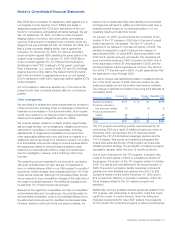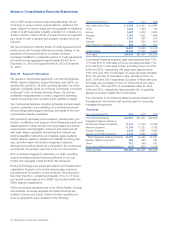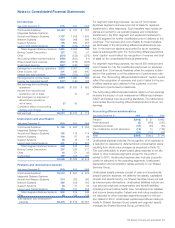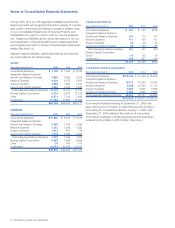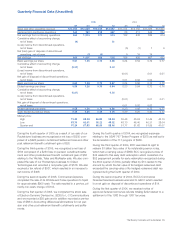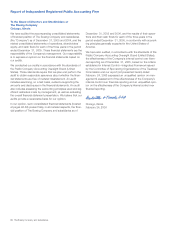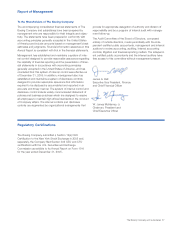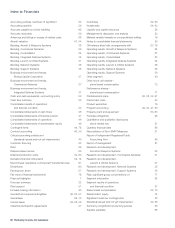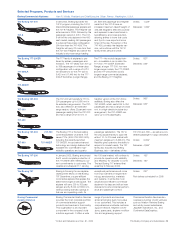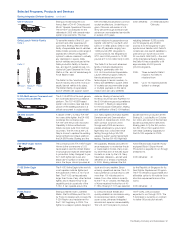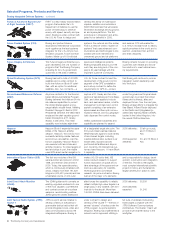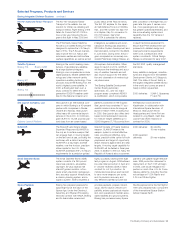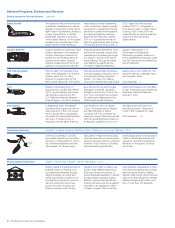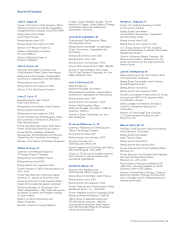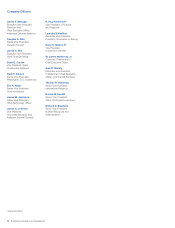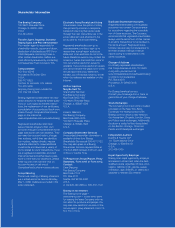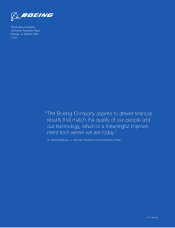Boeing 2005 Annual Report Download - page 93
Download and view the complete annual report
Please find page 93 of the 2005 Boeing annual report below. You can navigate through the pages in the report by either clicking on the pages listed below, or by using the keyword search tool below to find specific information within the annual report.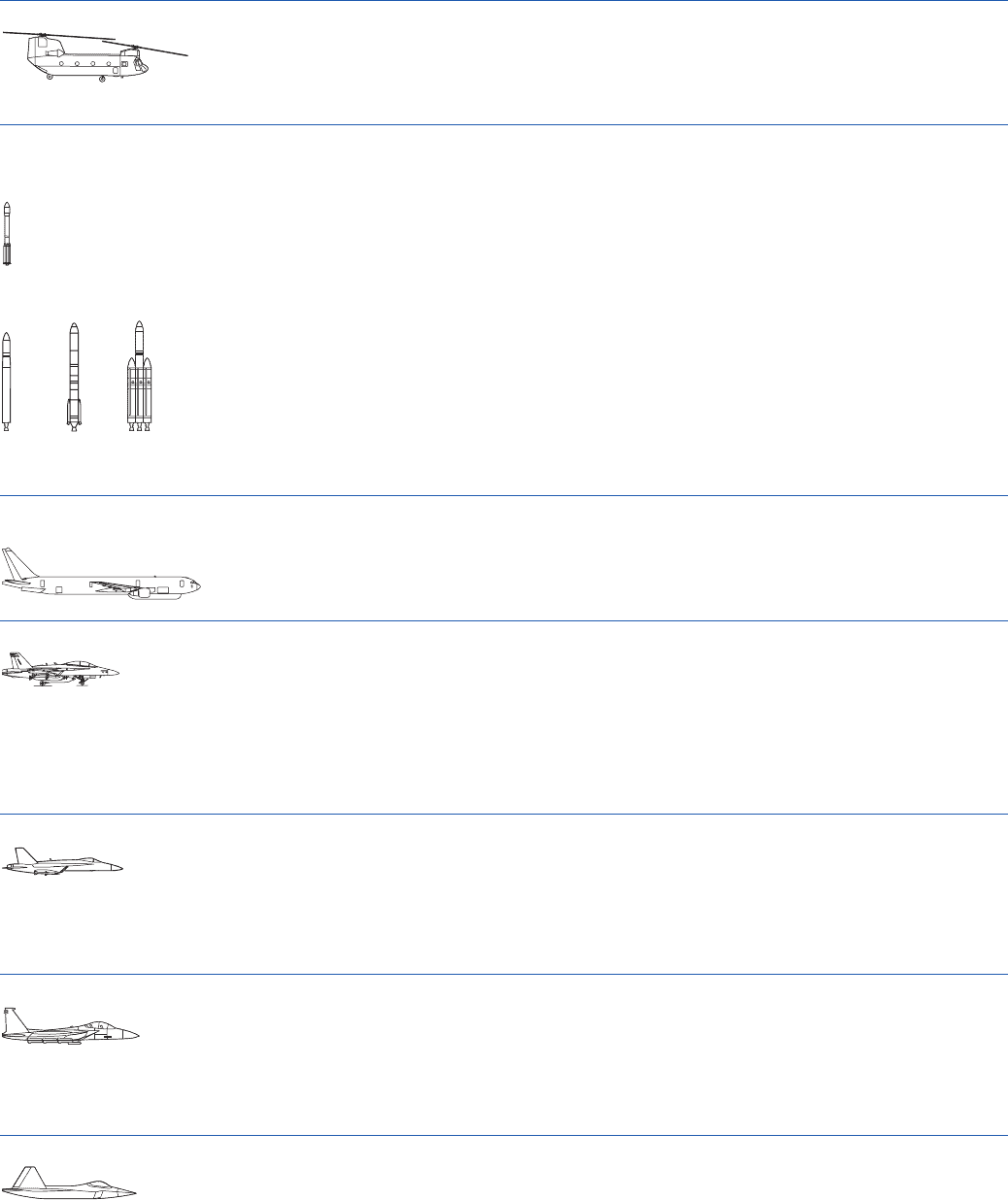
Selected Programs, Products and Services
Boeing Integrated Defense Systems continued
CH-47 Chinook Boeing is modernizing the U.S. MH-47G features advanced common 2005 deliveries: 21 remanufactured
Army’s fleet of CH-47 Chinooks and cockpit architecture. Under this pro- Chinooks
MH-47 Special Operations Chinooks. gram, Chinooks will remain in U.S.
The CH-47F is scheduled for first Army service through 2035 and will
deliveries in 2006 with several major achieve an unprecedented service life
system improvements. The new in excess of 75 years.
Delta Launch Vehicle Family
Delta II
Delta IV
Medium Medium Heavy
Plus
To serve the needs of the U.S. gov-
ernment and other space launch
customers, Boeing offers the Delta
family of expendable launch vehicles.
Delta rockets provide a wide range of
payload and vehicle configuration
options to deliver missions to virtually
any destination in space. Delta
launch vehicles are produced at the
Delta production facility in Decatur,
Ala., and launch operations are con-
ducted at Cape Canaveral Air Force
Station in Fla., and at Vandenberg Air
Force Base in Calif.
The Delta II is the “workhorse” of the
launch industry and is the most suc-
cessful launch vehicle in its class.
The Delta II family of expendable
launch vehicles can support space
launch missions to geosynchronous
transfer orbit (GTO), low-Earth orbit
(LEO) or to deep space. Delta II rock-
ets can lift payloads ranging from
1,965 pounds (891 kilograms) to
4,723 pounds (2,142 kilograms) to
GTO; and 5,934 pounds to 13,281
pounds (2.7 to 6.0 metric tons) to LEO.
The Delta IV is the most advanced
family of rockets developed by
Boeing in partnership with the
U.S. Air Force Evolved Expendable
Launch Vehicle program. Delta IV
blends advanced and proven
technologies to launch medium- to
heavy-size satellites to space. Delta
IV rockets can accommodate single
or multiple payloads on the same
mission and can carry satellites
weighing between 9,285 pounds
(4,210 kilograms) and 28,950
pounds (13,130 kilograms) to geo-
synchronous transfer orbit. Delta IV
rockets also can launch satellites to
polar and sun-synchronous orbit.
At Low Earth Orbit (LEO)—the orbit
of the International Space Station,
the Delta IV has a capability to lift
approximately 50,000 pounds
(23,000 kilograms).
2005: Three successful Delta II
missions; No Delta IV
missions flown
2006: Up to 12 missions planned
(subject to change)
E-10A Multi-sensor Command and
Control Aircraft (MC2A)
The E-10A-MC2A is the next-genera-
tion wide-area airborne surveillance
platform. The 767-400ER-based
system will provide a near real-time
picture of the battlespace and is a
critical component in cruise missile
defense. Boeing is teamed with
Northrop Grumman and Raytheon for
the E-10A airborne ground surveillance
Increment 1. Boeing is responsible
for the structural modification, testing
and certification of the E-10A testbed.
EA-18G Growler A variant of the U.S. Navy F/A-18F
two-crew strike fighter, the EA-18G
combines the combat-proven
F/A-18F with the proven Improved
Capability III Airborne Electronic
Attack avionics suite from Northrop
Grumman. The EA-18G is the U.S.
Navy’s choice to replace the existing
Airborne Electronic Attack platform,
the EA-6B Prowler. Boeing and the
U.S. Navy signed a five-year System
Development and Demonstration
contract on December 29, 2003. The
SDD contract runs from 2004
through early 2009 and encom-
passes all laboratory, ground and
flight tests from component-level
testing through full-up EA-18G
weapons system performance flight
testing. The first EA-18G flight test
aircraft went into production at the
Boeing St. Louis facility on October
22, 2004, and rollout of the first test
aircraft is scheduled for late 2006.
Boeing plans to fly the first produc-
tion EA-18G in third quarter 2007,
with Initial Operating Capability for
the EA-18G expected in 2009.
F/A-18E/F Super Hornet The combat-proven F/A-18E/F Super
Hornet is the cornerstone of U.S.
naval aviation and the United States’
most advanced multirole strike fighter
in production today. Designed to per-
form both fighter (air-to-air) and
attack (air-to-surface or strike) mis-
sions, the Super Hornet provides all
the capability, flexibility and perform-
ance necessary to modernize the air
or naval aviation forces of any coun-
try. More than 250 of the 284 Super
Hornets on order by the U.S. Navy
have been delivered— and all were
delivered on or ahead of schedule.
In 2005, Boeing delivered the first
Active Electronically Scanned Array-
equipped Block II Super Hornet.
Production is expected to run through
at least 2012.
2005 deliveries: 42
F-15E Strike Eagle The F-15E Strike Eagle is the world’s
most capable multirole fighter and
the backbone of the U.S. Air Force
fleet. The F-15E carries payloads
larger than those of any other tactical
fighter, and it retains the air-to-air
capability and air superiority of the
F-15C. It can operate around the
clock and in any weather. Since
entering operational service, the F-15
has a perfect air combat record, with
more than 100 victories and no
losses. Four other nations currently
fly the F-15. In October, the Republic
of Korea received the first two of 40
F-15Ks. Boeing’s F-15T was selected
by the Republic of Singapore for its
Next Fighter Replacement Program.
The F-15 remains a supportable and
affordable option to fill multirole force
struction requirements around the
world.
2005 deliveries: 4
F-22A Raptor Boeing is teamed with Lockheed
Martin, Pratt & Whitney and the U.S.
Air Force to develop and produce the
F-22A Raptor as a replacement for
the F-15C beginning in 2005. The
fighter is a weapon system designed
to overcome future threats and
quickly establish air dominance using
its revolutionary blend of stealth,
super cruise, advanced integrated
avionics and superior maneuverability.
The U.S. Air Force plans to procure
183 F-22As, with production
expected to run through 2013. The
F-22A team is currently on contract
to deliver 98 production aircraft.
The Boeing Company and Subsidiaries 91


